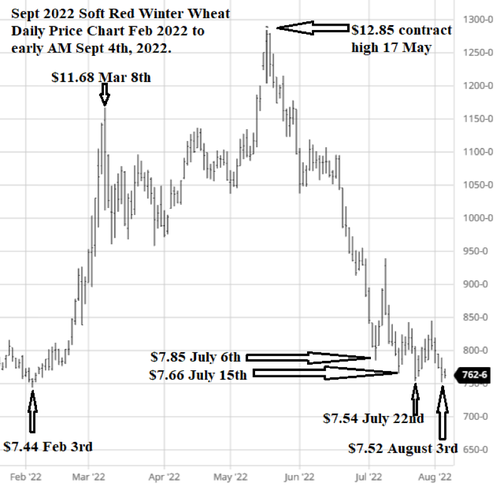
Editor’s note: This is a continuation of weekly articles about the use of put options on commodity futures as a primary marketing tool to lock-in a minimum price or as a price “enhancer” of forward contracts or HTA contracts.
This article discusses the process needed to maximize the income from the sale of a put option.
Since put options increase in value as the futures contract price declines, the first objective to maximize put income is to sell the put when the underlying futures contract price is as low as possible.
Picking a futures price near the bottom is much easier than picking a futures price near the top because commodity prices usually spend one to three months near the low, but only one to four days near the top. The time value of puts, in theory and most trading days, declines every day as it approaches expiration.
As one considers which day to sell a put, the futures price is the most important factor. However, one must weigh the remaining time value of an option that will be lost by expiration day of the option (when time value will be zero) and compare that to the probability the futures will make a new low for the move before expiration. Will that low be greater than the current time value? It is a classic “bird in the hand versus two in the bush” decision.
A look at ‘time value’
This morning (Aug. 4th, 2022), the three September put options we have been watching have 16½ business days of time value. A few minutes before they quit trading on the 26th of August, they will have no time value. So, let’s take a look at how much time value they have this morning.
The situation with the three Sept options we have been tracking since early April is this:
Strike price | $9.00 | $10.00 | $11.00 |
Sept futures price | $7.68 | 7.68 | 7.68 |
Intrinsic value* | $1.32 | 2.32 | 3.32 |
Option Premium** | $1.3925 | 2.3500 | 3.3625 |
Time Value cents/bu. | 7.25 | 4.5 | 4.25 |
* aka in-the-money value |
|
| |
** market value of the option |
|
|
The lower strike prices have the most time value. Why? Because the lower strike prices are closer to the current futures price and, thus, have the greatest risk of being in-the-money or out-of-the-money. With September futures at $7.68, it is highly unlikely that any of these options will expire out-of-money, but clearly, wheat is more likely to rally $1.32 to make the $9.00 put worthless than it is likely to rally $2.32 to make the $10 put worthless or $3.32 to make the $11 put worthless.
To carry the time value perspective a bit further, the $8.00 put is 32 cents in-the-money with a premium of 94 cents, so its time value is 62 cents! The $7.00 put premium is 49 cents, which is 100% time value, no intrinsic value because it is out-the-money. The $8 put is the closet strike price to the $7.68 futures, thus it has the greatest probability and risk of being in the money or out-of-the money on expiration. The more risk the greater the value of that risk. Term life insurance for an old duffer like me costs a lot more than it does for my grandsons, even though we both think we are quite healthy.
Take a look at the September wheat chart below. You can see it has been in the $7.50 to $7.90 area for a month. With three weeks before expiration, what are the chances September wheat will break below the $7.50 technical support compared to the chances of it breaking out of the sideways trading range above $7.90? Since September wheat is at $7.68 right now, should one wait for it to return to the $7.55 area to sell the put option or grab it now with a bit more time value then it will have any day for the next three weeks? As a market guy, I would recommend to not sell the $11, $10 or $9 puts today, but I would grab that huge time value of the $8 and $7 put this very moment. Next week, we will discuss the factors one should consider in deciding to sell the puts now or wait.

About the Author(s)
You May Also Like






